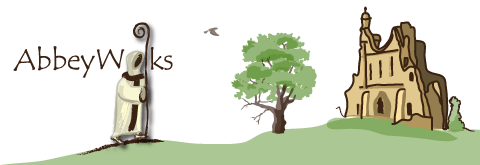

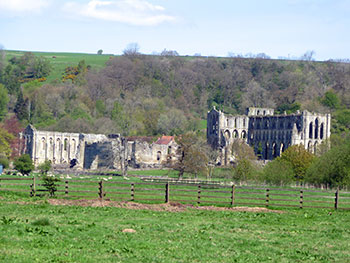 Rievaulx Abbey was founded as a Cistercian Abbey in 1131 and is the Daughter House of Clairvaux Abbey, France. It sits within the North Yorkshire Moors National Park, by the River Rye in a deep valley just a few miles from Helmsley.
Rievaulx Abbey was founded as a Cistercian Abbey in 1131 and is the Daughter House of Clairvaux Abbey, France. It sits within the North Yorkshire Moors National Park, by the River Rye in a deep valley just a few miles from Helmsley.
Rievaulx Abbey ( name taken from the nearby River Rye ) was the first and most northern Cistercian Abbey founded by St Bernard of Clairvaulx, and was one of the three Cistercian Abbeys named ‘ Shining Lights of the North ‘ along with Byland and Fountains Abbey. Its magnificent architecture ( which derived from it’s Mother Abbey Clairvaulx’s style ) was often replicated during the building of subsequent Cistercian Abbeys in the UK and in Europe.
Rievaulx Abbey is managed by English Heritage.
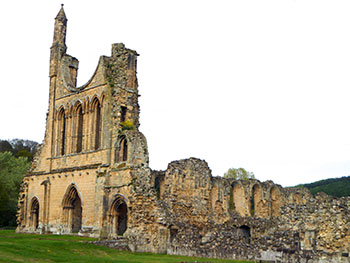 Byland Abbey was founded as a Cistercian Abbey in 1147 and is a Daughter House of Savigny Abbey, France. Along with Rievaulx and Fountains Abbey it was one of the three Cistercian Abbeys named ‘ shining lights of the North ‘.
Byland Abbey was founded as a Cistercian Abbey in 1147 and is a Daughter House of Savigny Abbey, France. Along with Rievaulx and Fountains Abbey it was one of the three Cistercian Abbeys named ‘ shining lights of the North ‘.
Byland Abbey is situated near the North Yorkshire village of Coxwold. The monks here were well known for their sheep-rearing skills and for the export of wool, and their community prospered.
The exceptionally large cloister and the scale of the church both reflect the size of the community which once lived here.
Byland Abbey is now managed by English Heritage
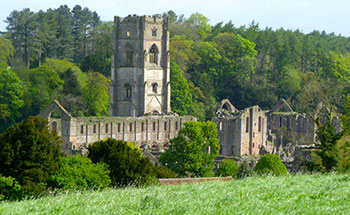 Fountains Abbey was founded in 1132, by a group of fleeing Benedictine monks from St. Mary’s in York. These monks craved a way of life that better followed the teachings of St Benedict, much like the first monks of Citeaux.
Fountains Abbey was founded in 1132, by a group of fleeing Benedictine monks from St. Mary’s in York. These monks craved a way of life that better followed the teachings of St Benedict, much like the first monks of Citeaux.
Fountains Abbey sits in the Skell Valley, a few miles west of Ripon, North Yorkshire, and is one of the three Cistercian Abbeys named ‘ shining lights of the North ‘, along with Rievaulx and Byland.
Fountains Abbey became the richest and largest of the northern abbeys. It is now a UNESCO World Heritage Site, holding the most significant Cistercian remains in Europe including the 12th century western range, and the oldest surviving Cistercian water mill.
Fountains Abbey is managed by the National Trust
* We provide both Guided and Self-guided walking holidays to Fountains Abbey *
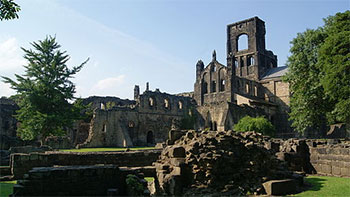 Kirkstall Abbey
Kirkstall AbbeyKirkstall Abbey was founded in 1147, and is a Daughter House of Fountains Abbey. It is situated in a valley close to the River Aire, and is approx 3 miles from Leeds city centre.
Kirkstall Abbey prospered based on sheep farming which led to the sale and export of sheep products including wool, milk, butter, leather and parchment. It is now one of Britain’s finest medieval monastic ruins.
Kirkstall Abbey is managed by Leeds City Council and is open to the public, with the Abbey House museum across the road from the Abbey ruin.
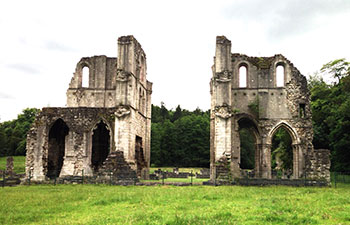 Roche Abbey was founded in 1147, and is a Daughter House of Rievaulx. It is situated in the valley of Maltby Beck, south of Maltby, South Yorkshire. It was a smaller abbey compared with other abbeys in Yorkshire, with approx 150 monks present at its peak.
Roche Abbey was founded in 1147, and is a Daughter House of Rievaulx. It is situated in the valley of Maltby Beck, south of Maltby, South Yorkshire. It was a smaller abbey compared with other abbeys in Yorkshire, with approx 150 monks present at its peak.
Part of the eastern end of the abbey still stands, along with the most complete ground plans shown in the form of excavated foundations that exist of any English Cistercian monastery.
Roche Abbey is managed by English Heritage.
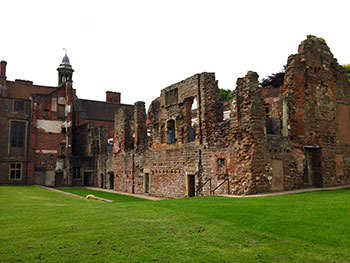 Rufford Abbey
Rufford AbbeyRufford Abbey was founded in 1147, and is a Daughter House of Rievaulx. It sits in the Nottingham countryside just 2 miles south of Ollerton. The abbey became a ruin after the Dissolution of the Monasteries in the 16th century and later became incorporated into the current day country house. The Cistercian abbey west cloister is the best preserved of it’s kind in England.
Rufford Abbey sits within what is now Rufford Country Park and is managed by English Heritage
Vaudey Abbey was founded in 1147, and is a Daughter House of Fountains Abbey. It is situated approx 4 miles northwest of Bourne, within the Grimsthorpe Castle park, Lincolnshire.
In its heyday the abbey flourished with bountiful wool profits, but fell along with other abbeys at the time of Henry VIII. Stone from the abbey was used to build a grand house in what were the Vaudey abbey grounds.
There are unfortunately no remains of the abbey to view except earthworks.
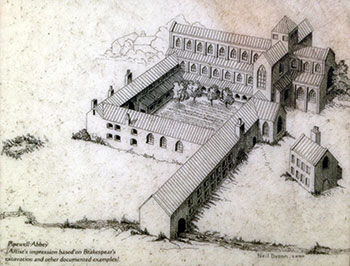 Pipewell Abbey
Pipewell AbbeyPipewell abbey was founded in 1143, and is a Daughter House of Newminster. Pipewell is a rural hamlet situated in the Northamptonshire countryside.
The Pipewell settlement is mentioned in the Doomsday Book. The abbey here was alive with its own infirmary, bakery, granary, brew-house, fishponds and gardens. The monks of the time built one of the first windmills of England on Harper’s Brook.
As with Vaudey, after the Dissolution much of the stone was used as building material for local grand houses.
Today there are no remains of the Abbey although the site where it once stood has been preserved and is now a Scheduled Ancient Monument.
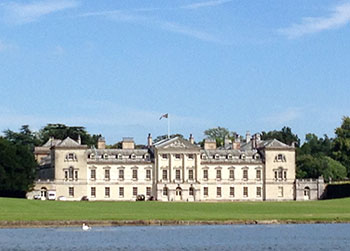 Woburn Abbey
Woburn AbbeyWoburn Abbey was founded in 1145, and is a Daughter House of Fountains Abbey. It is situated on the outskirts of the Bedfordshire village of Woburn.
Woburn Abbey is today the family seat of the Duke of Bedfordshire. It started to take the architectural form we see today around 1619 after it had become a private residence. There are a few markers indicating the original presence of the Cistercian abbey - the north wing of the current house sits on the site of the monastic church, and the current courtyard marks the outline of the great cloister and garth.
Legend has it that the last abbot of Woburn was hanged by Henry VIII from an oak tree that still stands in the grounds.
Woburn Abbey is open to the general public.
St Mary Graces was founded in 1350, and is a Daughter House of Beaulieu. It was situated just outside the Tower of London and was the last Cistercian abbey founded in England before the Dissolution. St Mary Graces was built in the immediate aftermath of the Black Death and sits on the site of a burial ground that was created in order to deal with the epidemic, and which later became The Royal Mint. This was the only Cistercian abbey built in a town setting.
There are no remains of the abbey to be seen today.
Image copyright and attribution information on this page: